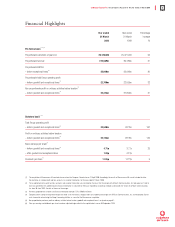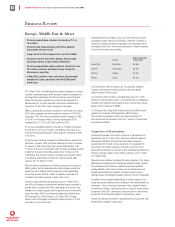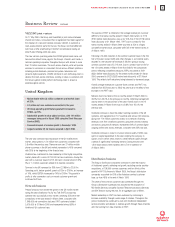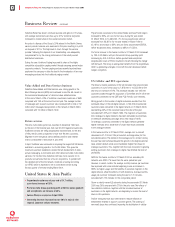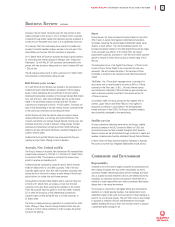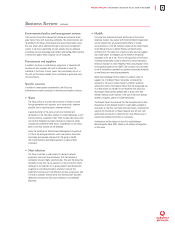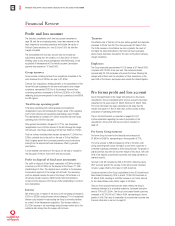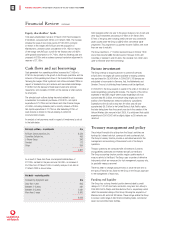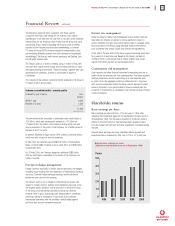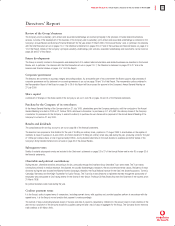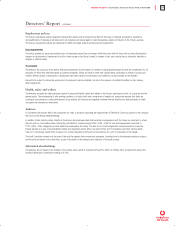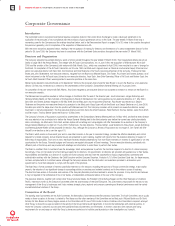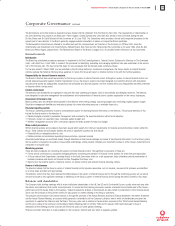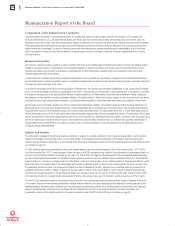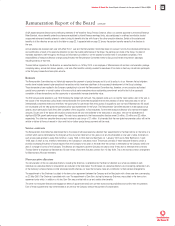Vodafone 2000 Annual Report Download - page 15
Download and view the complete annual report
Please find page 15 of the 2000 Vodafone annual report below. You can navigate through the pages in the report by either clicking on the pages listed below, or by using the keyword search tool below to find specific information within the annual report.
Vodafone AirTouch Plc Annual Report & Accounts for the year ended 31 March 2000 13
The Board has approved ratios consistent with those used by
companies with high credit ratings for net interest cover, market
capitalisation to net debt and net cash flow to net debt, which establish
internal limits for the maximum level of debt that the Group may have
outstanding. Group interest, excluding the Group’s share of interest
payable by joint ventures and associated undertakings, is covered
7.3 times by Group EBITDA (before exceptional reorganisation costs
and excluding dividends received from joint ventures and associated
undertakings). The Group’s main interest exposures are Sterling, Euro
and US dollar interest rates.
The Group’s policy is to borrow centrally, using a mixture of long term
and short term capital market issues and borrowing facilities, to meet
anticipated funding requirements. These borrowings, together with cash
generated from operations, are lent or contributed as equity to
subsidiaries.
The maturity of the undrawn committed facility available to the Group at
31 March 2000 is shown below.
Undrawn committed facility – maturity profile
Analysed by year of expiry: Euro
(million)
Within 1 year 9,500
Between 2-5 years 7,500
–––––––––
17,000
–––––––––
The committed facility comprises a syndicated senior credit facility of
30 billion, which was subsequently reduced to 17 billion on
11 March 2000. The portion of the facility maturing within one year
may be extended, at the option of the Company, for a further period of
between 6 and 12 months.
In addition, Misrfone in Egypt has an EGP2.4 billion committed facility,
which may only be used to fund its operations.
In May 2000, the Company issued US$3.75 billion of Floating Rate
Notes, of which US$0.75 billion is due in June 2001 and US$3 billion
in December 2001.
On 26 May 2000, the Company signed an additional US$5 billion,
364 day bank facility, extendable at the option of the Company by a
further 9 months.
Foreign exchange management
Foreign currency exposures on known future transactions are hedged,
including those resulting from the repatriation of international dividends
and loans. Forward foreign exchange contracts are the derivative
instrument most used for this purpose.
The Group’s policy is not to hedge its international net assets with
respect to foreign currency balance sheet translation exposure, since
net tangible assets represent a small proportion of the market value
of the Group and international operations provide risk diversity.
However, 66% of gross borrowings were denominated in currencies
other than sterling in anticipation of cash flows from profitable
international operations and this provides a partial hedge against
profit and loss account translation exposure.
Interest rate management
Under the Group’s interest rate management policy, interest rates are
fixed when net interest is forecast to have a significant impact on
profits. Therefore, the term structure of interest rates is managed within
limits approved by the Board, using derivative financial instruments
such as interest rate swaps, futures and forward rate agreements.
At the end of the year, 65% of the Group’s gross borrowings were fixed
for a period of at least one year. Based on the Group’s net debt at
31 March 2000, a one percent rise in market interest rates would
reduce profit before taxation by approximately £22m.
Counterparty risk management
Cash deposits and other financial instrument transactions give rise to
credit risk on the amounts due from counterparties. The Group regularly
monitors these risks and the credit rating of its counterparties and,
by policy, limits the aggregate credit and settlement risk it may have
with any one counterparty. Whilst the Group may be exposed to credit
losses in the event of non-performance by these counterparties, the
possibility of material loss is considered to be minimal because of these
control procedures.
Shareholder returns
Basic earnings per share
Basic earnings per share fell from 4.12p last year to 1.80p, after
adjusting the comparative figure for the capitalisation (bonus) issue on
30 September 1999. This includes a reduction of 6.32p per share in
relation to the amortisation of capitalised goodwill, arising primarily
from the merger with AirTouch and other acquisitions completed during
the year.
Adjusted basic earnings per share, calculated before goodwill and
exceptional items, increased by 25% from 3.77p to 4.71p this year.
Financial Review continued
0
1.0
2.0
3.0
4.0
5.0
Adjusted basic earnings per share
(adjusted for capitalisation issue on 30 September 1999)
1996 1997 1998 1999 2000
Pence


